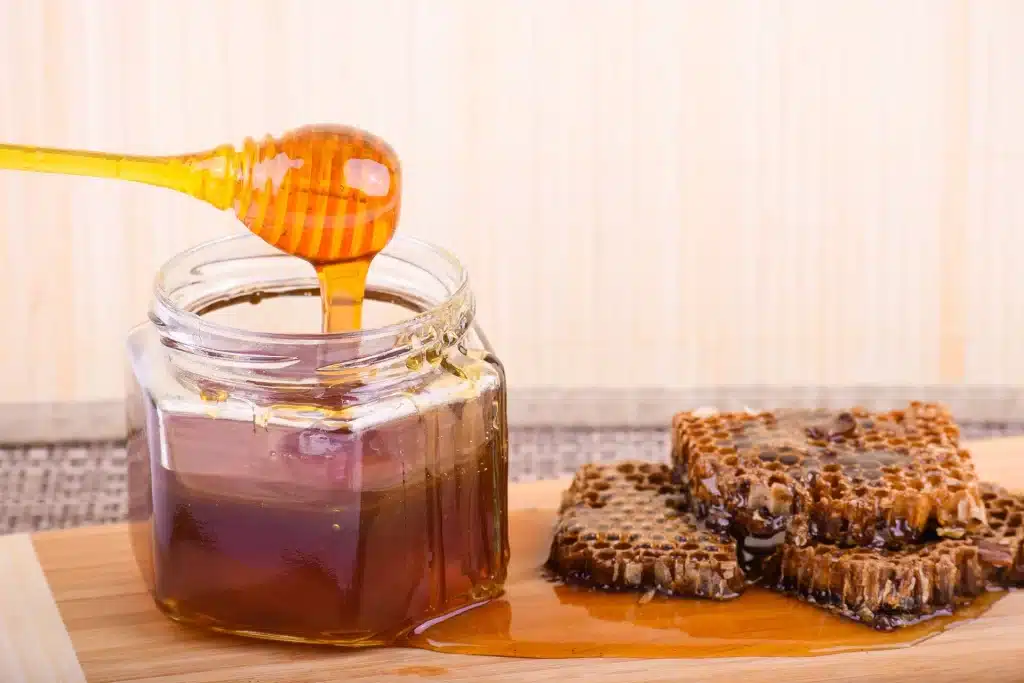You know what’s fascinating? Canada’s sprawling wilderness and incredible floral diversity create the perfect storm for producing some of the world’s most exceptional honey. But here’s the thing—figuring out if your honey is genuinely pure takes way more than just looking at it through the jar.
The global honey market is absolutely flooded with fake products right now. It’s honestly shocking how widespread this problem has become. That’s why understanding the quality of honey assessment isn’t just helpful; it’s essential if you want to make smart purchasing decisions.
When we talk about authentic Canadian natural raw honey, we’re diving into a world of sophisticated testing methods, strict regulations, and sourcing practices that completely separate the premium stuff from the cheap knockoffs flooding store shelves everywhere.
The Science Behind Canadian Natural Raw Honey Purity
Here’s where things get really interesting. Modern honey authentication doesn’t mess around; it uses cutting-edge lab techniques and incredibly strict oversight that makes old-school testing methods look primitive.
Hydroxymethylfurfural (HMF) level monitoring serves as a freshness indicator. Elevated levels suggest heat damage or extended storage periods. Wendell Estate Honey demonstrates exceptional farm-to-jar transparency and dedication to producing authentic raw honey. They’ve set themselves apart by obtaining GenuHoney certification—third-party verification that their products meet the highest purity of honey standards without any blending or batch processing.
The complexity of verifying real honey? It’s evolved dramatically. Why? Because the people creating fake honey have gotten ridiculously sophisticated with their adulteration methods.
Laboratory-Grade Purity Testing Methods
Advanced spectroscopy techniques are absolutely revolutionizing how we verify Canadian natural raw honey authenticity. We’re talking Nuclear Magnetic Resonance (NMR) and Fourier Transform Infrared Spectroscopy (FTIR) that can catch even tiny traces of synthetic sugars or adulterants that basic home tests would completely miss.
These methods? They analyze molecular structures at the microscopic level. Each honey sample gets its own unique fingerprint.
Isotope ratio analysis provides something pretty amazing—geographic authentication. It examines carbon and nitrogen isotope signatures that are specific to Canadian regions. This technology can actually tell you whether honey labeled as “Product of Canada” really comes from Canadian bees or if it’s mixed with imported substitutes.
But get this—honey is one of the top-three most adulterated foods in the world. That makes this kind of testing absolutely critical for protecting you as a consumer.
Pollen DNA analysis adds another verification layer. It identifies specific floral sources and confirms whether seasonal harvesting claims are legit. Plus, heavy metals and pesticide residue testing ensure that even pure honey meets safety standards for human consumption.
Canadian Food Inspection Agency (CFIA) Standards
The CFIA doesn’t play around with honey standards. They maintain strict definitions that distinguish “raw” from “natural” honey classifications within Canadian markets.
Raw honey? It can’t exceed 40°C during processing. Natural honey must stay unfiltered and unprocessed beyond basic straining. These legal distinctions exist to protect you from misleading marketing claims.
Commercial Canadian natural raw honey faces mandatory testing requirements. Moisture content regulations set a maximum threshold of 20%. Higher moisture levels? That indicates immature honey that’s prone to fermentation and quality problems.
Quality Indicators of Premium Canadian Raw Honey
Recognizing the exceptional quality of honey means understanding the unique characteristics that Canada’s diverse ecosystems and seasonal variations create. Regional differences significantly impact flavor profiles, nutritional content, and therapeutic properties.
Regional Terroir and Seasonal Variations
Prairie wildflower honey from Alberta and Saskatchewan? It exhibits completely distinct characteristics influenced by canola, clover, and native wildflower blooms. These varieties lean toward lighter colors with delicate, complex flavor profiles that change subtly throughout growing seasons.
Maritime clover honey from Nova Scotia and New Brunswick offers different mineral compositions reflecting coastal soil conditions.
Boreal forest honey varieties from Ontario and Quebec provide darker, more robust flavors with higher antioxidant concentrations. These regional variations aren’t just aesthetic differences—they reflect actual differences in nutritional content and therapeutic potential.
Seasonal quality fluctuations happen naturally as nectar flows change throughout the year. Early-season honey often crystallizes more slowly than late-season varieties, while autumn honey typically contains higher enzyme concentrations.
Physical and Chemical Quality Markers
Crystallization patterns reveal important quality information about authentic Canadian natural raw honey. Pure honey crystallizes naturally over time. Smaller, smoother crystals indicate higher quality than large, coarse formations.
Electrical conductivity measurements help identify mineral content and detect potential adulteration.
Free acidity and lactone content provide insights into honey maturity and storage conditions. Proline levels serve as bee enzyme indicators, confirming that honey underwent complete ripening processes within the hive rather than artificial concentration methods.
Canadian Honey Sourcing and Production Excellence
Sustainable sourcing practices and production methods completely distinguish premium Canadian honey from mass-produced alternatives. Understanding these practices helps you make informed decisions about honey sourcing and product authenticity.
Indigenous Beekeeping Knowledge Integration
Traditional harvesting methods from First Nations communities offer incredibly valuable insights into sustainable beekeeping practices. These time-tested approaches emphasize minimal hive intervention and seasonal timing that respects natural bee cycles.
Modern apiaries increasingly collaborate with indigenous knowledge keepers to develop sustainable practices rooted in traditional wisdom.
Such partnerships create unique benefits of raw honey through methods that prioritize bee health over maximum production. This approach often results in higher-quality honey with enhanced therapeutic properties, though production volumes may be smaller than industrial operations.
Certified Organic and Biodynamic Honey Production
Organic certification requirements in Canada mandate pesticide-free radius requirements of minimum of 3 kilometers around apiaries. This ensures bees can’t access contaminated nectar sources during foraging flights.
Biodynamic farming principles incorporate lunar cycles, soil health, and holistic hive management approaches. Transition periods for organic certification require three years of verified pesticide-free management before products can carry organic labels.
Advanced Benefits of Raw Honey Beyond Basic Nutrition
The therapeutic potential of authentic Canadian natural raw honey extends way beyond simple sweetness. It offers scientifically-proven health benefits unique to unprocessed varieties. Understanding these benefits of raw honey helps justify premium pricing for quality products.
Microbiome Support and Prebiotic Properties
Oligosaccharides naturally present in raw honey varieties support beneficial gut bacteria growth and digestive health enhancement. These complex sugars survive stomach acid to reach the colon, where they feed probiotics and support overall microbiome balance.
Clinical research demonstrates synergistic effects when raw honey is consumed alongside fermented foods.
Different Canadian honey varieties contain varying oligosaccharide profiles. Darker honeys typically offer higher concentrations of prebiotic compounds. This explains why some people experience different digestive benefits from various regional honey types.
Bioactive Compounds Unique to Canadian Honey
Regional phenolic profiles reflect the specific plant communities surrounding Canadian apiaries. These compounds provide antioxidant protection and anti-inflammatory benefits that vary seasonally based on blooming patterns.
Antimicrobial peptides from Canadian bee species offer natural preservation properties and potential therapeutic applications.
Comparison studies with international honey varieties consistently show Canadian raw honey among the highest in antioxidant capacity, particularly varieties from boreal forest regions with diverse plant communities.
Storage, Preservation, and Culinary Mastery
Proper storage techniques maintain the exceptional quality of honey and maximize therapeutic benefits throughout extended periods. Understanding preservation methods ensures you receive full value from premium Canadian natural raw honey purchases.
Optimal Storage Techniques for Quality Preservation
Temperature control parameters require consistent cool conditions between 10-21°C to prevent enzyme degradation while avoiding crystallization acceleration. Humidity control prevents moisture absorption that can trigger fermentation in raw honey varieties.
Light exposure prevention maintains vitamin content and prevents breakdown of sensitive compounds.
Container materials significantly impact long-term quality preservation. Glass containers provide optimal protection, while certain plastics can absorb honey aromas and potentially leach chemicals over time.
Culinary Pairing and Enhancement Techniques
Cheese and honey pairing principles create sophisticated flavor combinations that highlight regional honey characteristics. Aged cheddar complements prairie wildflower honey beautifully, while goat cheese pairs perfectly with darker boreal forest varieties.
Craft cocktail integration methods preserve raw honey’s beneficial enzymes when added to room-temperature or slightly chilled beverages.
Baking temperature considerations become crucial when using raw honey. Excessive heat destroys therapeutic compounds and enzymes that distinguish raw varieties from processed alternatives.
Future Innovations in Canadian Honey Quality Assurance
Technological advances continue to revolutionize how we verify and maintain honey quality standards. These innovations promise greater transparency and consumer confidence in Canadian natural raw honey markets.
Artificial Intelligence in Quality Prediction
Machine learning algorithms analyze multiple quality parameters simultaneously to predict honey characteristics and detect potential issues before they impact consumer products. Predictive modeling helps beekeepers optimize harvesting timing and storage conditions for maximum quality of honey retention.
Automated grading systems development streamlines quality assessment processes while reducing human error in evaluation procedures. Internet of Things (IoT) integration enables real-time hive monitoring for optimal production conditions.
Sustainability Certifications and Carbon Footprinting
Carbon-neutral honey production initiatives address environmental concerns while maintaining quality standards. Bee welfare certification programs establish industry standards for ethical beekeeping practices.
Zero-waste apiary operations demonstrate that sustainable honey sourcing can achieve both environmental and quality objectives simultaneously.
Circular economy principles in honey packaging reduce environmental impact while preserving product integrity through innovative container designs and materials.
Final Thoughts on Canadian Honey Excellence
Canadian natural raw honey represents something truly special, an exceptional combination of pristine environmental conditions, rigorous quality standards, and sustainable production practices. The purity of honey and quality of honey available from Canadian sources rivals the world’s finest varieties while supporting local ecosystems and beekeeping traditions.
Understanding proper honey sourcing empowers you to access authentic products that deliver the maximum benefits of raw honey for health and culinary applications. Choose Canadian raw honey not just for its exceptional taste, but for the assurance of quality that comes from a nation truly committed to environmental stewardship and authentic food production. You deserve honey that’s as pure as the Canadian wilderness it comes from.
Your Honey Questions Answered
Which country produces the purest honey?
New Zealand’s Manuka, Yemen’s Sidr, Hungary’s Acacia, and Spain’s Miel Lo Mejor del Bierzo represent some of the world’s purest varieties, though Canada’s diverse regions produce equally exceptional raw honey with stringent purity standards.
How to verify authentic Canadian honey at home?
Check for natural crystallization, perform water tests where pure honey settles without dissolving quickly, and look for CFIA certification labels. Authentic raw honey should have complex aromas and never taste overly sweet.
What makes Canadian raw honey different from processed varieties?
Raw Canadian honey retains natural enzymes, pollen, and beneficial compounds that processing destroys. The purity of honey remains intact without heating, filtering, or blending that commercial processing typically involves.







